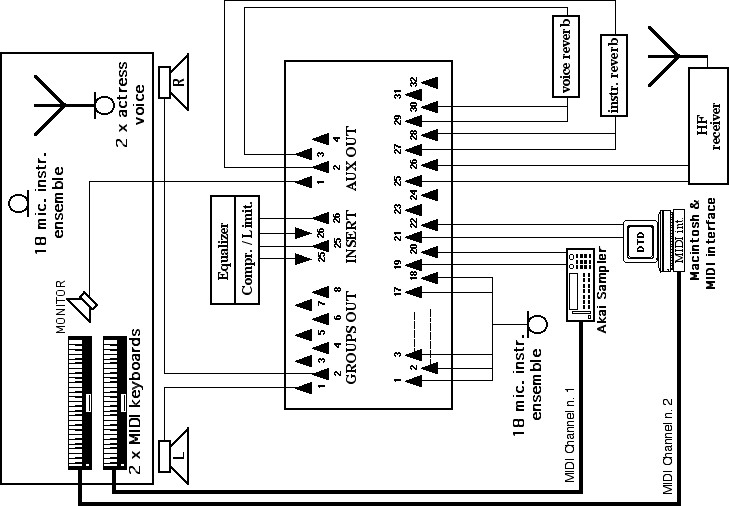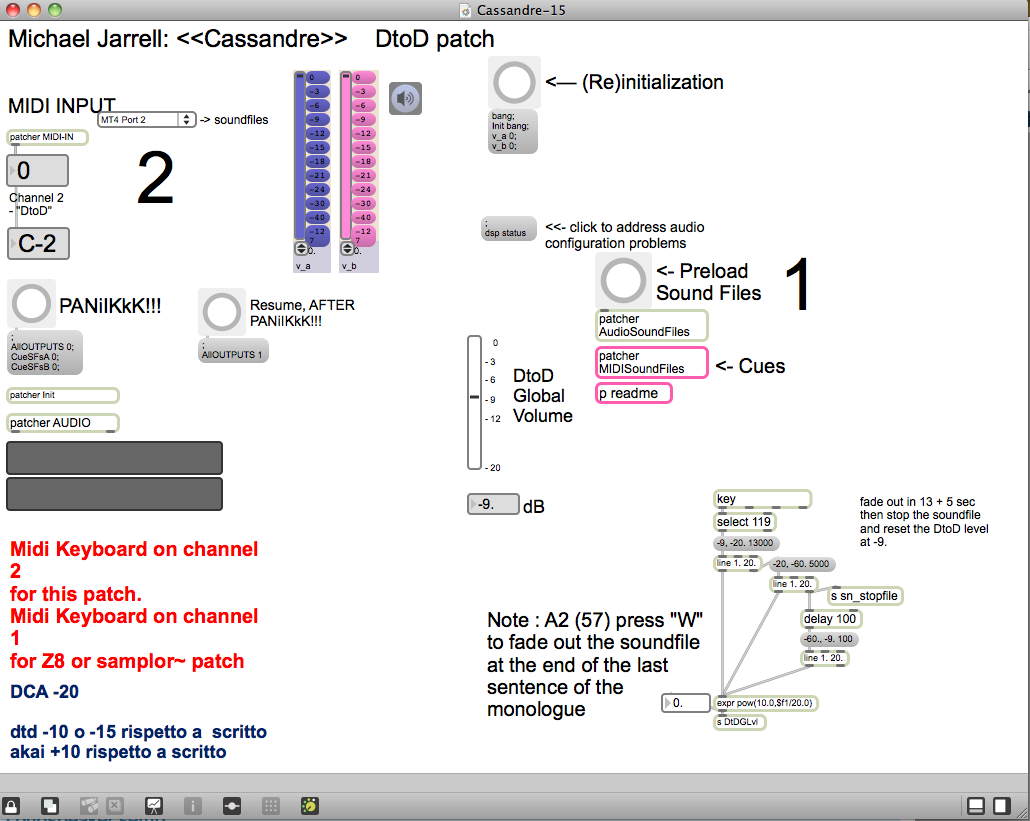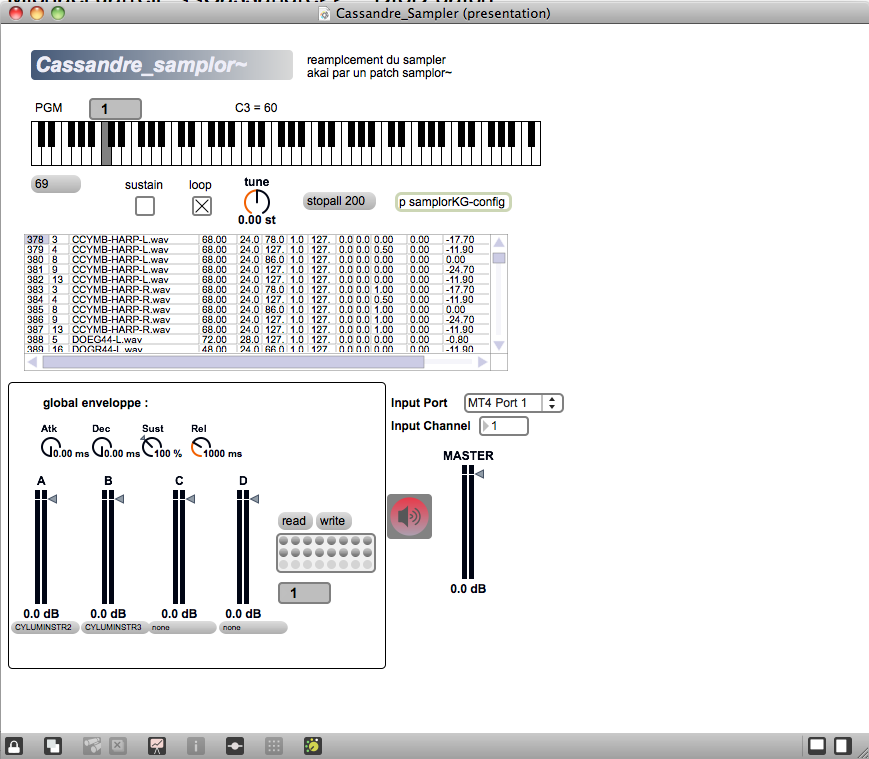Table of contents
Documentation date: 2 février 2022
Version state
Valid
Validation date: 2 février 2022
Version documentalist
- lemouton (Serge.Lemouton@ircam.fr)
Version realisation
- David Poissonnier (Sound engineer)
- Augustin Muller (Computer Music Designer)
Version length
1 h 5 mnUpgrade Motivation
Patches updated to Max 8.
Sampler and DtD patch gathered in a single max project.
Comment
Untested in performance.
Other version(s)
- Michael Jarrell - Cassandre - Genève - 2015
- Michael Jarrell - Cassandre - Samplor version - no akai
- Michael Jarrell - Cassandre - Lugano2012
- Michael Jarrell - Cassandre - cassandre-aout-2010
- Michael Jarrell - Cassandre - cassandre-patch-sampler-externe-2010
- Michael Jarrell - Cassandre - 2006 Mac OSX
Detailed staff
- soliste : actrice
- flûte, hautbois, clarinette, clarinette basse, basson, 2 cors, trompette, trombone, 2 percussionnistes, piano, clavier électronique/MIDI/synthétiseur, violon, violon II, alto, violoncelle, contrebasse
Channel details
- Number of output channel : 4
Electronic equipment list
Computer Music Equipment
-
1 MacBook Pro - Apple Laptops
(Apple)
-
1 Max 8 - Max
(Cycling74)
-
1 Sound Board - Sound Board
Number of analog output:2 , Sampling Rate : 44100 -
1 KX 76 - MIDI Keyboard
(Yamaha)
was connected directly to the Akai sampler, now controls the Cassandre_Sampler max patch. Range used : from F#0 (MIDI pitch 30) to G5 (MIDI pitch 91) [Heavy touch:1] [Key number:76] -
1 KX 88 - MIDI Keyboard
(Yamaha)
to be connected to the Macintosh computer to trigger sound files, via the MIDI interface. Used from C0 (MIDI pitch 24) to G#6 (MIDI pitch 104) [Heavy touch:1] [Key number:88] -
1 Midi interface - MIDI Interfaces
to interface the 88 key MIDI keyboard to the Macintosh Computer [Port type:USB] [I/O number:1 input]
Audio Equipment
-
2 Dynamic microphone - Dynamic Microphones
Wireless microphone for the voice (actress) -
18 Dynamic microphone - Dynamic Microphones
for the orchestra -
1 HF System - HF System
-
2 Amplifier - Amplification
-
2 Loudspeaker - Loudspeakers
-
1 Mixing Console - Mixing Console
-
1 Effect processor - Effects Processor
Equalizer for the voice (actress) -
1 Effect processor - Effects Processor
Compressor/limiter for the voice (actress) -
2 Effect processor - Effects Processor
Reverberations : one for the voice (actress), the other for the instrumental ensemble
Work related information
Premiere
- 4 février 1994, Paris, Théâtre du Châtelet
Publisher :
- Lemoine
Realisation
- Pierre Charvet
Work length
- 1 h 5 mn
Useful links on Brahms
- Cassandre monodrame pour comédienne, ensemble instrumental et électronique (1993-1994), 1h5mn
- Michael Jarrell
| File | Author(s) | Comment | |
|---|---|---|---|
| Download [12,3 Kio] | Other midi file | midi file to test sampler patch | |
| Download [391,0 Mio] | Patch All-in-one Max project | Serge Lemouton | |
| Download [539,3 Mio] | Audio file(s) CASSANDRE2009-MIXSANSVOIX.aif | For rehearsal purpose only - DO NOT DISTRIBUTE ! | |
| Download [573,2 Mio] | Audio file(s) MasterSansVoixCassandreOrigineCD.aif | For rehearsal purpose only - DO NOT DISTRIBUTE ! (alternate version) |
Instructions
Audio Setup
The electronic part of Cassandre requires a stereo frontal diffusion. The voice and the ensmble should be amplified.
No real time transformation.
Audio/MIDI setup diagram - General Stage, Audio and MIDI Setup

Software setup
This version of Cassandre uses 2 patchs:
- cassandre2022 to play the soundfiles (direct to disk samples), controlled by keyboard 1 (midi channel 2)
- Cassandre_Sampler to replace the original AKAI Sampler, played on keyboard 2 (midi channel 1, customizable, see below ) and change the different programs by pgmchange messages.
To load all the max patches simply open the cassandre2022.maxproj project : Both patches are automatically launched.
Max Sampling rate should be set to 44.1 kHz, Vector Size 64. Overdrive On.
The cassandre2022 folder contains all the applications, patcher source files, sound files, etc. required for the Macintosh computer to perform the piece.
The source files are provided so that you can eventually modify them, if you have your own licenced Max application.
Patches presentation
cassandre2022 , DtoD sounds, Midi channel 2

In the present version, this Max patch only implements the so-called “DtoD” (direct to disk): the playing of sound files triggered by MIDI pitches from the 88 key keyboard. The patcher feeds only two audio outputs (see dac~ 1 2 object in the AUDIO sub-patcher).
After installation (see “Software setup” above) the main Max patcher is ready at once upon opening. Only the preload of the sound files must be performed manually, by clicking on the main patcher’s button marked Preload Sound Files.
The Max patch receives MIDI Note On messages from the keyboard, on MIDI Channel n° 2 (two), and triggers the appropriate sound files.
The audio output level can be modified with the DtoD Global Volume potentiometer. It is set to -9 dB by default. This default value can be changed permanently.
At any time, the C7 key (MIDI pitch 108) can be played to stop a file during its playback. Certain other keys, according to the score, also intentionally stop a playing sound. Some other keys have no effect.
The [x] key of the computer keyboard can also be used to stop playback.
It is possible to simulate manually the incoming of a MIDI Note On from the keyboard, in order to test the patcher. Open the MIDI-IN sub-patcher with a double-click. You can then click in the right hand number box marked To simulate a pitch manually, and type in the desired MIDI pitch followed by return, or use the onscreen keyboard.
Cassandre_Sampler, samplers sounds, Midi channel 1

Select the appropriate midi input with the menu.
Select the audio output with the Audio Status menu.
Check program changes.
Levels tuning and enveloppe are stored and recalled on a program-by-program basis using the preset object.
You can save and load your own configuration, but note that current balance and enveloppe were adapted with the composer.
Performance notes
keyboard 1 : A2 (57) or press “W” to fade out the soundfile at the end of the last sentence of the monologue.
© IRCAM

This documentation is licensed under a Creative Commons Attribution-NonCommercial-NoDerivatives 4.0 International License.
Program note
Ce monodrame a été inspiré par la comédienne suisse Marthe Keller. Le texte, de l'écrivain allemand Gerhard Wolf, est basé sur le livre de Christa Wolf, Kassandra, interprétation moderne du drame grec. Deux versions, musicalement identiques, sont envisagées : la première en français, pour le théâtre du Châtelet, et la deuxième en allemand. L'ensemble est constitué de 18 musiciens, auxquels s'ajoute une partie électronique constituée d'échantillons déclenchés par un clavier dans l'orchestre. Le défi est d'intégrer les sons électroniques dans l'orchestre traditionnel, ceci pour élargir le champ des sonorités d'une manière cohérente ; ce n'est qu'à deux occasions, pendant une heure que dure la pièce, que l'électronique, pour des raisons dramaturgiques, joue un rôle de premier plan.
None
Version documentation creation date: 2 février 2022 12:31, update date: 11 mai 2022 12:10